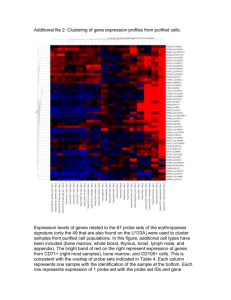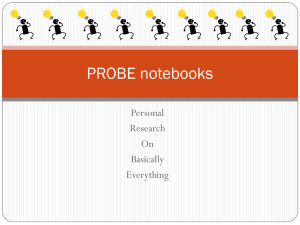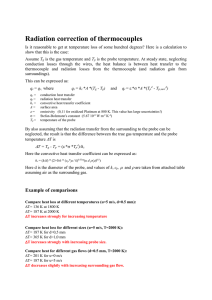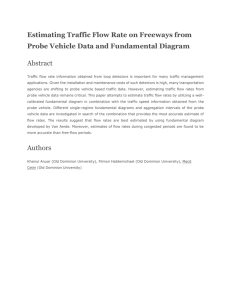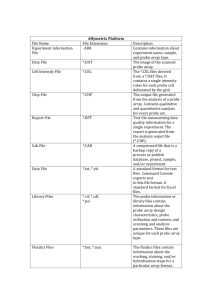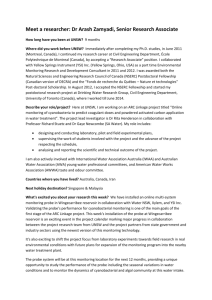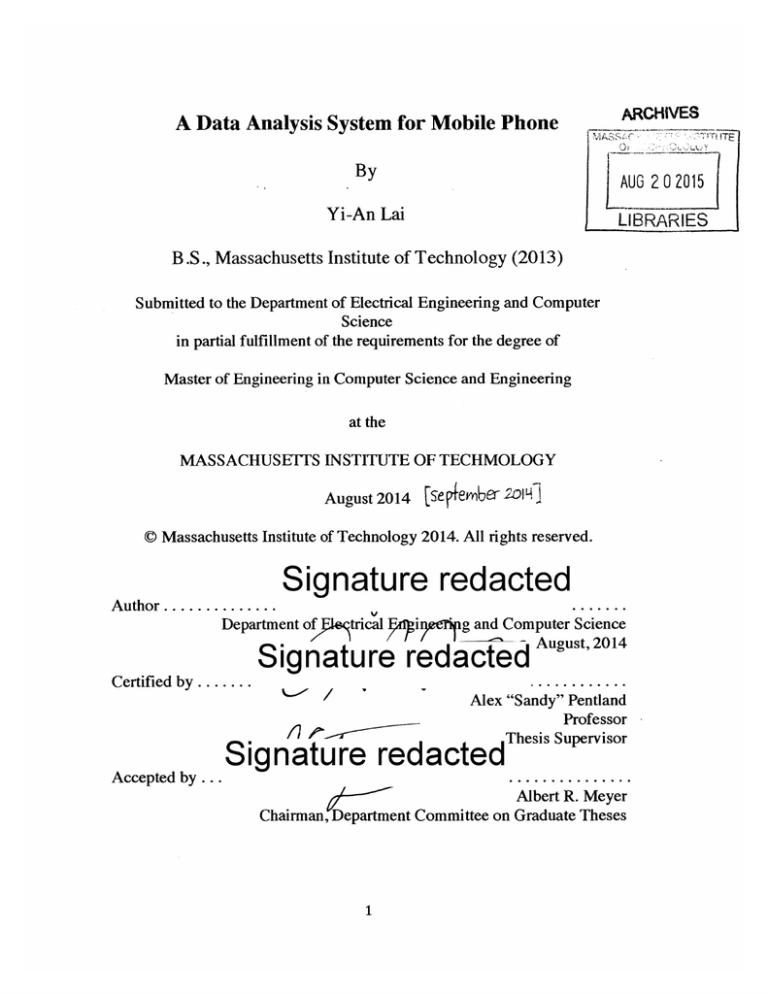
A Data Analysis System for Mobile Phone
By
ARCHIVES
AUG 2 0 2015
Yi-An Lai
LIBRARIES
B.S., Massachusetts Institute of Technology (2013)
Submitted to the Department of Electrical Engineering and Computer
Science
of
the
requirements for the degree of
in partial fulfillment
Master of Engineering in Computer Science and Engineering
at the
MASSACHUSETTS INSTITUTE OF TECHMOLOGY
August 2014 [Se*emr 2-014
0 Massachusetts Institute of Technology 2014. All rights reserved.
Signature redacted
Author..............
Department of
trical F1ei
g and Computer Science
Signature redacted
Iugust, 2vi-+
Certified by .......
e/7
.........
Accepted by ...
Alex "Sandy" Pentland
Professor
Signature redacted
Thesis Supervisor
Albert R. Meyer
Chairman, Department Committee on Graduate Theses
1
2
A Data Analysis System for Mobile Phone
By
Yi-An Lai
Submitted to the Department of Electrical Engineering and Computer Science
on August 22, 2014, in partial fulfillment of the
requirements for the degree of
Master of Engineering in Computer Science and Engineering
Abstract
This thesis shows the experiment of using the mobile phone application Social Health
Tracker to collect participants' mobile phone data and survey answers regarding their
social, physical activity and mental concentration level. It also shows the design and the
implementation of a Data Analysis System that provides automation for generating
Relationship Graphs of the mobile phone data and the survey answers. The system can be
broken into three parts. The system first takes the raw data that are in CVS format to
generate Probe Data Packages, which are the data from the mobile phone, and the Survey
Data Packages, which are the data from survey answers. The system then takes each of
the Probe Data Packages and their corresponding Survey Data Package to generate
Formatted Data, which will be further used to create Relationship Graphs. Multiple
Relationship Graphs have been generated to demonstrate the results of the experiment
and the feasibility of the system from the development perspectives.
Thesis Supervisor: Alex "Sandy" Pentland
Title: Professor
3
4
Acknowledgements
First of all, I would like to thank my thesis advisor, Sandy Pentland, for allowing me to
work in his group. Human Dynamics Group is by far the most interesting and diversed
lab that I've ever worked in. Furthermore, Prof. Pentland has always been very helpful in
providing insights and guiding the direction of the project.
I would like to thank Brian Sweatt for helping me with all the questions from the
first day I joined the lab. He has been the best collaborator and mentor who would
respond immediately to my lengthy emails with all the questions and always find time to
have meetings with me to provide me suggestions on the project. I would like to thank
Arek Stopcsynski for keep me company in the office and sending me different resources
that are relevant to my research.
Lastly, I would like to think my parents, Linda Bergkamp and Steve Bergkamp for
constantly reminding me to concentrate on my goal and to always try my best on
whatever that I am working on. I would like to also thank my grandmother for always
believing in me when I ran into any obstacles.
5
6
Contents
1
2
1.1
Motivations.............................................12
1.2
Related Works..........................................
13
1.2.1
Mobile Phones Data Set.............................
13
1.2.2
Individual Based Data Collection ......................
14
16
Methodology
2.1
Overview ...............................................
2.2
Related W orks...........................................16
2.3
Mobile Phone Data Collection System ........................
2.3.1
3
12
Introduction
Privacy Considerations ..............................
16
18
21
2.4
Community Overview ....................................
22
2.5
Probe Data .............................................
22
2.5
Survey Data ............................................
24
Implementing the Data Analysis System
28
3.1
Overview .............................................
28
3.2
Data Package Creation ....................................
28
Data Formatting ...................................
29
3.2.1
3.3
Generating the Formatted Data ..............................
31
3.3.1
Activity .........................................
32
3.3.2
Bluetooth ........................................
33
3.3.3
Call Logs ........................................
34
3.3.4
SMS ............................................
35
3.3.5
Screen ..........................................
37
7
3.3.6
Wi-Fi ...........................................
38
3.4 Data Graphing ..........................................
40
4
Conclusion and Future Work
43
A
Graphs
48
8
List of Figures
2-1
Overview of the back-end data flow ..........................
2-2 Overview of the Phone System ..............................
2-3
Sample survey from the Social Health Tracker App ..............
2-4 Sample user result from the Social Health Tracker App...........
3-1
Overview of the Data Package Creation .......................
3-2
Overview of generating the Formatted Data ...................
3-3
Overview of generating the Relationship Graphs .................
3-4 Relationship Graph example ...............................
9
List of Tables
2.1
Detailed information of signals collected by the Funf Framework
2.2 Survey question of socialization ...............................
2.3
Survey question of mental concentration ........................
2.4 Survey question of physical activity ............................
10
Listings
Listing 3.3.1: Generating the Formatted Data from the Accelerometer Probe.
Listing 3.3.2: Generating the Formatted Data from the Bluetooth Probe .....
Listing 3.3.3: Generating the Formatted Data from the Call Log Probe ......
Listing 3.3.4: Generating the Formatted Data from the SMS Probe .........
Listing 3.3.5: Generating the Formatted Data from the Screen Probe .......
Listing 3.3.6: Generating the Formatted Data from the Wifi Probe .........
11
Chapter 1
Introduction
1.1 Motivation
Most smart phones now have built in sensors that measure motion, orientation and
different environmental conditions. All these sensors are capable of providing raw data
with high precision and accuracy,
such as monitoring three-dimensional
device
movement or positioning or monitoring changes in the ambient environment near a
device.[l] With the advancement of the smart phone technology, it has granted us an
unprecedented ability to observe and collect users' behaviors, such as how physically
active they are, how frequently do they make phone calls or send messages or where are
the places they have been to, as quantified data and further analyze it.
Given the technology and smart phone's ubiquitous presence, which had reached 1
billion in 2012, a 47 percent increase from a year earlier, this provides scientists a large
amount of data and gives rise to the computational social science. [2] Computational
social science is the interdisciplinary science of complex social system and it studies
individual people or in groups using big data, such as mobile phone history, emails, GPS
traces, Wi-Fi points, and data from social networks. [3] In the research paper,
Computational Social Science, Lazer, Pentland, et al. mention that digital data could
potentially increase our understanding of the underlying information of individuals. [4]
Due to the passive nature of smart phone's data collection where the mobile device
is able to collect information without any interaction with the user, the information could
potentially provide us insights of user's day-to-day routines. The goal of this project is to
utilize the data collected from the mobile phone and survey answers gathered from the
12
users to infer individual's level of socialization, mental focus ability and physical activity
level and utilize effective data visualization to present the data. The project aims to
investigate the relationships between different signals and survey responses from the
participants. If we can demonstrate certain data's ability to infer those three subjects, the
predictions generated from the mobile phone data can potentially be used medically as a
tool to provide people suggestions on improving the conditions on those three areas or be
used by doctors as a reference to better understand patients' social and physical behavior
in order to better assist them.
1.2 Related Works
Utilizing a large data set that is collected over a long duration of time for learning about
participants' behaviors and health conditions in an attempt to improve them has been a
rather common practice in various research fields. Nevertheless, in the past, collecting
such data is not only costly but also required enormous amount of effort and time.
Moreover, it is also hard to retain a large number of research participants over a long
period of time when the data collection requires researchers to seek information from the
participants actively. As the result, the throughput of data samples in research that utilize
this kind of practice is often very low.
However, given the recent advancement of the mobile phone technology, mobile
phones are always continuously collecting information from the users and this requires no
active interaction with the users for their input of the information. Furthermore, we are
able to leverage on mobile phone's ubiquitousness to obtain data that has very high
sampling rate.
1.2.1 Mobile Phones Data Set
In "Reality mining: sensing complex social system," Eagle and Pentland designed a
system for sensing complex social systems with data collected from 100 mobile phones
over the courses of 9 months. They demonstrated that using standard Bluetooth-enabled
mobile telephones to collect data, such as call records, Bluetooth proximity logs, could
13
provide us great insight on social network and individual's behavior pattern. [5]
In "Inferring friendship network structure by using mobile phone data," Eagle,
Pentland, etal. compares observational data from mobile phones with standard self-report
survey data. [6] They found that information of the two data sources is overlapping but
distinct, and they demonstrated that it is possible to accurately infer 95% of friendships
based on the observational data alone. [6] And the behavioral patterns could potentially
predict the individual-level outcomes such as their job satisfaction.
1.2.2 Individual Based Data Collection
Although we could benefit from the large scale data sets provided from the service
providers, this information is constrained in specific areas, such as call history, emails,
texts, financial transactions. In "Social Sensing for Epidemiological Behavior Change,"
Madan et al. [7] tackled the problem of gathering individual's data with an alternative
approach by collecting this information through survey questionnaire. This approach
allows the researchers to obtain contextual information on the end users. [7] Madan et al.
present the results based on mobility and communication pattern that mobile phone
sensing data could potentially be used for measuring and predicting the health condition
of the users. [8]
14
is
Chapter 2
Methodology
2.1 Overview
The research goal of this project is to better understand the potential correlation between
participants' health and social behaviors and the information collected from their mobile
phone data. In this experiment, a mobile phone application, Social Health Tracker, was
required be downloaded by the participants and the application will send survey
questionnaires to the participants to collect their information. The survey questionnaires
required the users to assess their own health, social and mental status and report to the
application. The mobile phones were used as sensors to gather information of users'
activities on the phone, such as phone calls, text messages, Bluetooth signals, Wi-Fi
points and the history of the accelerometer. Users were required to have an Android OS
based mobile phones to download the application and participate in the study. The project
did not sponsor the mobile device or the phone plans, so the participants would have their
own android phones for the study.
2.2 Related Works
In "Social fMRI: Investigating and shaping social mechanisms in the real world,"
Aharony et al.[2] developed a mobile-phone-based social and behavioral sensing
system and deployed in the wild for over 15 months (see Figure 2-1). This sensing
system runs on Android operating- system based mobile device and it can passively
and continuously collect a broad range of data signals without any active input from
the users. Each type of signal collected by the system is encapsulated as a conceptual
"probe" object [9] The probes terminology is used rather than "sensors" as probes
16
include traditional sensors such as GPS or accelerometer, but also other types of
information not traditionally considered as sensor data, such as file system scans or
logging user behavior inside applications. [9] The back-end system processes all the
incoming SQLite files, inserts them into a central MySQL database, and sends email
reports to investigators about status of phones and alerts of any issues . [9] An
object-relational-mapper (ORM) then enables representing all data as code objects.
[9]
Rotating Sqlite DB F
Auto notification
(e.g. Phone not uploading)
MQLhm
7
MU\
Back-End
Aggregator
(ORM)
Reports
Analysis Experimental
Applications
Figure 2-1: The overview of the back-end data flow
The dataset that we obtained in this research was collected using this system with a
configuration that included over 25 different types of data signals. In addition to this
signal collection system, we also included an on-phone survey component, which
the mobile application, Social Health Tracker, was to be downloaded by the
participants on the mobile phone and it would send out surveys to the participants
twice a day.
17
2.3 Mobile Phone Data Collection System
Android operation system based mobile phones with social and behavior software
sensing platform were used to collect users' survey answers and data from the mobile
phone sensors (see Figure 2-2). The software for sensing platform, Funf Opening Sensing
Framework, configured to periodically sense and record over 25 different types of data
signals, such as call logs, text logs, Bluetooth signals, Wi-Fi signals, accelerometer
history. We required our participants to download the Social Health Tracker application
that's available on Google Play. This application sends out surveys to the users twice a
day (see Figure 2-3). The application enables the users to see their activity levels in a
timeline fashion and also presents the result of their activity levels compared to other
users (see Figure 2-4). This system is designed to continuously run in the background and
will trigger to make sure itself restarts when the phone turns on or after the service is
terminated.
[9] The system schedules different data collection
actions
and the
configuration is set so that battery intensive actions are performed in intervals allowing
usefulness while minimizing battery drain. [9] We did not provide mobile phone plans or
data plans. Participants used their own Android phones with desired provider and the
mobile phones had to be the primary phone for the duration of the study.
18
Wifi
Configurations, Surveys
On -Phone Surveys
Movement
Pro es
Calls/Texts
0*0
Bluetooth Signals
R eality Analysis App
w ith Funf system
Figure 2-2: Overview of the Phone System
19
~-You were:mostly alone and in a quiet
·place ·
Choose one ...
/ You were around other peopJe; but did
not interact much
. ~hich stat ement best.describes _
your-".
l.ever of sod alization over the last 15 ·
-,;· rmites?' .
.
~~You.were around others and •
~~interacted with-a moderate numbe.r of
·_them-. ·
Choose one...
~--~~~·~-,. ...,.,.......~-~-....-....,......--
~-You interacted with
:acquaintances
many friends_and
-_You tnteracted with as many people
~_- ~s possib!e-.
Figure 2-3: Sample smvey on participant's mobile phone screen
20
Activity
My Social Health
Rcen
activty
Suser
10
Average
ocia[
8*5.0
44.0
Focus
r
eves%"
Wous
4.53.5-
3.0-
4
25
2.5
2Aj
0.0
00
N
-,
C~
LL
0)
N
04(C/
c00
Figure 2-4: Sample result that shows participant's levels of physical activity, mental
focus ability and social activity in comparison to other users (left). Sample result
shows participants mental focus levels on a time line (right).
2.3.1 Privacy Considerations
This study was conducted under strict protocol guidelines. Our primary concern for the
design of the research was to protect the privacy and sensitive information of our
participants. To achieve this, all participants' real world personal identifiers are linked to
coded identifiers. For instance, participants are represented as numbers in our database
and there's no sufficient information available in the database that will allow anyone to
link the participants and the numbers together. All human-readable information, such as
phone numbers, text messages, is encrypted as hashed identifiers. No information is ever
21
saved in clear text. The study aimed to be unobtrusive as possible to the participants' life
routines. The data collection of the mobile phone sensors did not require any interactions
from the users. The only out-of-routine behavior that asked of participants was filling out
surveys twice per day. And the surveys did not ask for anything personal information
from the participants.
2.4 Community Overview
The pilot test of this research started in 4/18/2013 with 21 participants. All the
participants are members of Human Dynamics Group.
2.5 Probe Data
To collect the mobile phone data, we used the Funf Open Sensing Framework, an
Android-based extensible framework developed by MIT Media Lab. This framework
provides us a reusable set of functionalities enabling the collection, uploading, and
configuration for a broad range of data type. [10] The data collected is automatically
saved in SQLite format. When the user is in the absence of network access, the phone
will accumulate the collected database files locally; when server connection is available,
the system will them upload the files to the central system. [9] In order to minimi7e the
impact on the user, probes built using Funf coordinate with each other to reduce power
and processor usage. [10] The following table lists different signals that are collected by
different probes during different interval of time.
22
ActivityProbe
60s
Information about how active the person is. Uses
the AccelerometerProbe data to calculate how
many intervals the variance of a device's
acceleration is above a certain threshold. Intervals
are 1 seconds long. DURATION (default 5s)
AndroidlnfoProbe
3600s
Information about the version of Android the
device is running.
BatteryProbe
300s
Information about the type and current state of the
battery in the device.
BluetoothProbe
300s
Detects Bluetooth devices within range.
CallLogProbe
3600s
Information about the calls that are made by the
device. Sensitive information is normalized and
hashed consistently and can be compared to
contacts on this device, or with other devices.
CellProbe
1200s
Information about the ids for the current cell tower
the device is connected to.
HardwarelnfoProbe
300s
Information about the specific hardware the device
is running, including component identifiers.
LightSensorProbe
3600s
Information about the ambient light level in SI lux
units. DURATION (default 60s)
LocationProbe
1800s
Information about the longitude and latitude.
ProximityProbe
3600s
Information about far the front of the device is
from an object. DURATION (default 60s)
ScreenProbe
N/A
Information about when the screen turns off and
on.
23
SmsProbe
3600s
Information about messages sent and received by
this device using SMS. Sensitive data is hashed for
user privacy.
TimeOffsetProbe
21600s
Checks NTP servers to determine the devices
current offset from the times ervers.
WifiProbe
1200s
Information about the available Wi-Fi access
points.
Table 2.1: The detailed information of each signal that is collected by the Funf Open
Sensing Framework.
2.6 Survey Data
In this experiment, participants would complete the survey on a regular basis on their
mobile phone. The surveys would be sent out to them twice a day at random time. They
would be asked questions regarding their level of socialization, ability to concentrate on
tasks and level of physical activity level of the last 15 minutes. The data included the
following signals:
(1) Socialization:
Socialization refers to any in person face to face interaction. Interactions that are
conducted via phone calls, web mails or online social network do not belong to this
category. The socialization information was self-reported by participants twice a
day on a daily basis where the options of the level of socialization provided
included:
24
Which statement best describes your level of socialization over the last 15
minutes?
1 You interacted with as many people as possible
2 You interacted with many friends and acquaintances
3 You were around others and interacted with a moderate number of them
4 You were around other people, but did not interact much
5 You were mostly alone and in a quiet place
Table 2.2: Survey question of socialization
(2) Mental concentration
Mental concentration is defined by how focus participants are on any kind of task
they are doing. The socialization information was self-reported by participants
twice a day on a daily basis where the options of the level of mental concentration
provided included:
Which statement best describes your ability to focus and concentrate on tasks
over the last 15 minutes?
I There was extreme focus and you were "inthe zone*
2 You were very focused and could easily concentrate on the task(s) at hand
3 There was a moderate level of concentration and focus
4 You were somewhat focused and could concentrate a little
5 You could not focus and concentrating was impossible
Table 2.3: Survey question of mental concentration
(3) Activity
Activity is defined by how physically active participants are. This category is not
limited to sports, activities in the gym or outdoor exercise. For instance, walking
around in the office frequently could be considered as physically active. The
socialization information was self-reported by participants twice a day on a daily
basis where the options of the level of physical activity provided included:
25
Which statement best describes your level of activity over the last 15 minutes?
I An extremely high level of physical activity was performed
2 A very active level of physical activity was performed
3 A moderate level of physical activity was performed
4 A little physical activity was performed
5 Mostly sedentary and engaged in little to no physical activity
Table 2.4: Survey question of physical activity
26
27
Chapter 3
Implementing the Data Analysis System
3.1 Overview
Analyzing the data involves many steps from formatting and cleaning the raw data
to generating graphs that show the relationship between the signal data collected
from probes and the survey answers provided by the participants. First, the system
takes the raw data to generate Probe Data Packages and Survey Data Packages,
which are data that have been reorganized with selected features that we desired.
Next the system takes each of the Probe Data Packages and their corresponding
Survey Data Package to create data files that are in a standard format The system
then takes those data files to generate the Relationship Graphs that present the
relationship of the mobile phone signals and survey answers.
3.2 Data Package Creation
The raw data from the mobile phone, including the probe data and the survey data,
are originally saved in the CSV file format and they are around 2 GB. This CVS file
includes the signal data from the mobile phone probes and the collected survey
answers. The system first takes the CVS file to process it into the format with
timestamps as the header, and the desired features in each row. This step limits the
size of the data packages to 5MB each. The process of transforming the raw CSV file
into individual data package is the longest step in the set up process. However, once
the individual data packages are created, the system will not need to repeatedly run
the entire CSV file when it is retrieving data of the probes or the survey answers.
28
Generator Scripts
Probe Data Packages
Survey Data Packages
~12 ~IZ]
I-I
I-I
U-I
I-I
I-I
I-I
L~J LTJ
~Z] CII]
I-I
*in*
I-E
I-I
I-I
I-I
L~J L~J
Figure 3.1: Overview of Data Package Creation - the system takes the raw CVS file
and feeds it to the Generator Scripts. The Generators Scripts then creates Probe Data
Packages and Survey Data Packages.
3.2.1 Data Formatting
Instead of taking all the features of the data, as seen in the following examples, we
only select certain features of the data by deleting other columns in the data set.
Generator.py takes the raw CSV file and generates the Probe Data Packages and the
Survey Data Packages with selected features.
29
Probe data example from the raw CVS file:
2|BluetoothProbell386098113.6841{u'android-bluetoothdevice-extra-device': {u'maddress':
u'CB:6E:44:D1:18:1D'}, u'timestamp': 1386098113.684,
u'android-bluetooth-device-extra-rssi': -91, u'androidbluetooth-device-extra-class': {u'mclass': 7936},
u'android-bluetooth-device-extra-name': u'One'}
Survey data example from the raw CSV file:
2IActivityPast3Daysl1380208365.41612
3lActivityPast3Daysl1380208369.77813
4lActivityPast3Days|l384965021.49514
The followings are the processed CSV file with selected header and features. For the
probe data, Generator.py selects desired features and eliminates the rest, then
makes the time stamp as the header.
Processed probe data example from raw CSV file:
1380063872.1021{u'android-bluetooth-device-extra-device':
{u'maddress': u'04:0C:CE:21:6A:15'}, u'timestamp':
1380063872.102, u'android-bluetooth-device-extra-class':
{u'mclass': 38E1356}, u'android-bluetooth-device-extrarssi': -95}
For the survey data, the Generator.py selected the time stamp as the header and
survey answer as the desired feature in the second column.
Processed survey data example from raw CSV file:
1380208365.41612
1380208369.7781 3
1384965021.49514
In the end, Generator.py creates 6 Probe Data Package for each of the following
signals: activity, Bluetooth, call logs, text logs, screen on-off history, and Wi-Fi
signals. It also creates 3 Survey Data Package for the following survey categories:
physical activity, social activity, and mental concentration.
30
3.3 Generating the Formatted Data
Among the 14 signals collected by the probes, we chose 6 signals to further study
the relationships between those signal data and the survey answers. There is a
Sensor Script for each signal to take the Probe Data Package and the corresponding
Survey Data Package as input to organize data into a dictionary as following format:
{timestamp: [probe data, survey answer]}
For instance, the Accelerometer.py takes the Accelerometer Data Package and all of
three Survey Data Packages to produce the Formatted Data. Since survey
questionnaire asks the participants about their condition in the past 15 minutes, the
Sensor Script selects all the data that are collected 15 minutes prior from the point
that the participants answer the survey.
Survey Data Package
Probe Data Package
Sensor Scri t
Formatted Data
31
Figure 3.2: Overview of how the system generates Formatted Data - once the Probe
Data Package and Survey Data Packages are created, Sensor Script takes each of the
Probe Data Packages and their corresponding Survey Data Package to create the
Formatted Data.
33.1 Activity
Activity sensor records how activate the person is. It uses the data from the
Accelerometer Probe to calculate how many intervals the variance of a device's
acceleration is above a certain threshold and the intervals are 1 seconds long.[10]
The default duration of the probe is 5 seconds and the default period is 60 seconds.
Example Data:
{
u'timestamp': 1386098903.072,
u'totalintervals': 14,
u'high~activity-intervals': 0,
u'lowactivity-intervals': 0
}
The survey questionnaires ask the participants about their condition in the past 15
minutes, therefore Activity.py calculates the activity level by summing up the all
data of the high-activityintervals in the past 15 minutes from the point when the
participants submit their surveys.
Listing 3.3.1: Generating the Formatted Data from the Accelerometer Probe
#This wiLL give me the value of the data from funf
datavalue = ast.literaleval(j[1])
high activity intervals = data_value['highactivity_intervals']
lowactivity intervals = str(data-value[ 'lowactivity intervals'])
# If the timestamp of the funf data is 15 minutes(900 seconds) prior from the
point when the survey data is collected, then we add up the
highactivity intervaLs vaLue
if
- data_time) >= 0 and (survey time - datatime) <= 900:
[surveyvalue, temphighactivityintervals]
(surveytime
32
+
temphighactivity intervals = temphigh_activityintervals
high_activityintervals
finaldata[surveytime] =
[surveyvalue,temphighactivityintervals]
3.3.2 Bluetooth
Bluetooth sensor detects the Bluetooth devices within range from your mobile phone.
The default period is 300 seconds.
Example Data:
{
u'android-bluetooth-device-extra-device':
{
u'maddress': u'CB:6E:44:D1:18:1D'
u'timestamp': 1386098113.684,
u'android-bluetooth-device-extra-rssi': -91,
u'android-bluetooth-device-extra-class':
{
u'mclass': 7936
u'android-bluetooth-device-extra-name': u'One'
}
Each device has its unique media access control address (MAC address). MAC
address is represented as 'maddress' in the data and is a combination of 12
alphanumeric characters that can contain numbers from 0 to 9 and letters from A to
F. [12] MAC address is an unique identifier assigned to network interfaces for
communications on the physical network segment [11] In Bluetooth.py, it sums up
all the unique 'maddress' within the 15 minutes prior the survey is collected to
calculate the number of unique devices around participant's mobile phone.
Listing 3.3.2: Generating the Formatted Data from the Bluetooth Probe
#This will give me the value of the data from funf
33
datavalue = ast.literaleval(j[1])
premaddress = datavalue[ 'android-bluetooth-device-extra-device'J
maddress = str(pre-maddress['maddress'])
the funf data is 15 minutes(980 seconds) within the survey data, then we
add up the unique "zaddress'
# If
if
(surveytime - datatime)
>=9 and (surveytime
- datatime)
<=900:
tempset.add(maddress)
finaldata[survey_time]
= [surveyvalue, len(tempset)]
333 Call Logs
Call log sensor records the calls that are made by the device. All the sensitive
information, such information, such as the name of the receiver and the phone
number, is normalized and hashed consistently and can be compared to contacts on
this device, or with other devices. [10] The default period is 300 seconds.
Example Data:
{
u'name':
u '{
"ONEWAYHASH" : "8af6611da3b93cf c392fb216dc319a52f58daaf7"
u' numberlabel':
u '{
"ONEWAYHASH":""
u'numbertype':
u'{
"ONEWAYHASH" :"77de68daecd823babbb58edblc8el4d7l06e83bb"
u'number':
u'{
"ONEWAYHASH" :"d72al8dc360226be5bdObf96cb94eefb1fcc3374"
u'date': 1380571060066L,
u'timestamp': 1380571060.066,
u'duration': 102,
u' id': 12,
u'type': 1
}
34
"
As shown in the example, all the sensitive information is hashed. " u'duration'
represents the duration of the phone call in seconds. CallLog.py sums up the all the
phone call duration during the 15 minutes time frame prior the survey is submitted by
the participants.
Listing 3.3.3: Generating the Formatted Data from the Call Log Probe
#This wiLL give me the value of the data from funf
datavalue = ast.literaleval(j[1])
callduration = data-value['duration']
#This help us prevent coLlecting the data into final-data when there is no
matching between the survey and the data
if (survey-time - data-time) >= 0 and (surveytime - data-time) <=
900:
callcount = callcount + callduration
finaldata[surveytimel = [surveyvalue,call_count]
elif
(surveytime
break
- datatime) <
0:
33.4 SMS
SMS sensor records messages sent and received by the device using SMS and all the
sensitive data are hashed for users' privacy. [10] The default period is 3600 seconds.
Example Data:
{
u'body':
u'{
"ONEWAYHASH": "ca6ca17b1b8bc4b9e134f498f97a406593824b90"
}',
u'servicecenter': u'+12404492162',
u'locked': False,
u'person': u'{
"ONEWAYHASH":"9f682df245668969bbcd5395bdc2882591eeecde"
u'read': True,
u'timestamp': 1380632699.765,
u'reply-path-present': False,
35
u'threadid': 10,
u'status': -1,
u'address':u'{
"ONEWAYHASH":"eff26f4c007e64bl311e439762bfbc5ac8371e86"
u'date': 1380632699765L,
u'protocol': 0,
u'type': 1,
u'subject': u'{
"ONEWAYHASH":""
}}
The data have hashed information for the content of the messages, name of the
sender, and the address of the sender. " u'read' " indicates whether the mobile
phone user has read the text message, and "u'replypath " indicates whether the
user has replied to the text message. Sms.py calculates the number of unique
messages that have been read by the participants.
Listing 3.3.4: Generating the Formatted Data from the SMS Probe
#This wiLl give the time stamp of the survey, it
converted using ast.LiteralevaL.
T-f ,sd.
it
doesn't need to be
wiLL give error.
survey_time = i[0]
#This wilL give me the value from Survey
survey_value = ast.literal-eval(i[1])
#This is the temporary value for the count of 'screenon'
sms_count = 0
for
j in data:
#Th is wiLl give me the time stamp of the data
datatime =
from funf
j[e]
#Th is wiL L give me the value of the data from funf
datavalue = ast.literaleval(j[1])
sms_read = data-value['read']
36
True
#This help us prevent collecting the data into final data when there
matching between the survey and the data
# If the funf data is 15 minutes(990 seconds) within the survey data,
is no
then
we add up the highactivity intervals value
if
(surveytime
- datatime) >= 0 and (surveytime
- data-time)
<=
900:
#We only collect the data if
if sms_read is True:
the user has read the data
sms_count = sms_count + 1
final_data[surveytime] = [surveyvalue,smscount]
33.5 Screen
Screen sensor records when the screen turns off and on. [10]
Example data:
{
u'timestamp': 1386022720.941,
u'screenon': False
I
Screen.py calculates all number of records with the screen to be on within the 15
minutes prior from the survey is collected.
Listing 3.3.5: Generating the Formatted Data from the Screen Probe
#This wiL l give me the value of the data from funf
datavalue = ast.literaleval(j[1])
screenvalue = data-value['screen_on']
#This help us prevent collecting the data into final-data when there is no
matching between the survey and the data
# If the funf data is 15 minutes(998 seconds) within the survey data, then
we add up the highactivity intervals value
if
(surveytime
- datatime)
>= 0 and (surveytime
- data-time)
900:
#We only collect the data if
een is on.
the scr
print 'Found'
screencount = screencount + 1
finaldata[surveytime] = [surveyvalue,screencount]
37
<=
and added to the list. In this
way, when we Loop a new i, we don't have to visit
# the data that we have visited before.
# If the funf data is beyond 15 minutes of the survey data, then we stop
the Loop and choose the next survey data
# We remove funf data that we have visited
(surveytime
elif
print
'not
- datatime) <
0:
found'
3.3.6 Wi-Fi
Wi-Fi sensor records all the available Wi-Fi access points detected by the mobile
phone.
Example data:
{
u'distancesdcm': -1,
u'ssid': u'MIT GUEST',
u'bssid': u'00:26:cb:f4:83:ee',
u'level': -87,
u'timestamp': 1386098103.864,
u'capabilities': u'[ESS]',
u'distancecm': -1,
u'frequency': 5320,
I
IVd
**
1
(
U wifissiU' {
u'octets': {
u'count': 9,
u'buf': [77, 73, 84, 32, 71, 85, 69, 83, 84, 0, 0, 0, 0, 0, 0, 0, 0, 0,
0, 0, 0, 0, 0, 0, 0, 0, 0, 0, 0, 0, 0, 0]
}
}
}
Every Wi-Fi access point has its unique Service Set Identifier (SSID), which is a case
sensitive, 32 alphanumeric character identifier attached to the header of packets sent over
a wireless local area network that acts as a password when a mobile device tries to
connect to the basic service set. [13] The system is designed to scan the Wi-Fi points
around the device every 15 minutes. We would like to use the Wi-Fi points to estimate
the relative movement of the participants. Therefore, Wifi.py takes the probe data from
38
the Probe Data Package and the following equation to calculate the Wi-Fi score:
ore = (Previous wifi SSID set) U (Current wifi SSID set)
(Previous wifi SSID set) A (Current wifi SSID set)
Wifi.py first generate a dictionary of Wi-Fi score and its matching timestamp. Then
it takes the data from the Survey Package, find all the Wi-Fi data with timestamp that's
within 15 minutes prior from the point when the survey is submitted and generates the
final dictionary with survey answers, Wi-Fi score and their corresponding timestamp.
Listing 3.3.6: Generating the Formatted Data from the Wifi Probe
#This wiLL give me the value of the data
from funf
datavalue = ulta[key]
the funf data is 15 minutes(99G seconds) within the survey data, then
we add up the highactivity intervals value
# If
if
(survey-time
- data-time)
>=
0 and (survey time - data-time) <=
900:
finaldata[surveytime] = [survey-value, data-value]
39
3.4 Data Graphing
Once the Sensor Script generates the Formatted Data, the Graphing Script takes the data
and creates the Relationship Graphs between the sensor data and the survey answers.
Formatted Data
Graphing Script
Relationship Graphs
Figure 3.3: Overview of how the Relationships Graphs are generated - the Graphing
Script takes the Formatted Data generated by the Sensor Script to create
corresponding Relationship Graphs of the probe data against the data of
socialization, physical activity and mental concentration.
40
For instance, the Graphing Script takes the data of activity probe against the data of
the survey answers regarding participant's social, activity and physical levels (See
Figure 3.4).
Activity Probe vs Acitvity Verification
40
A
35
j..Median
Average~
A
A
A
30
A
A
AA
, 25
0
A-
..
A
A
A
A
A
A
AA
AA
A
A
A
A
A
>,20
U
< 15
10
5
0
1. 0
1.5
2.0
2.5
3.0
3.5
4.0
4.5
5.0
Activity Verification
Figure 3.4 : The B elationship Graph of the data of Activity Probe against the data of
physical a ctivity.
41
42
Chapter 4
Conclusion and Future Work
Conclusion The data analysis system allows researchers to generate Relationship Graphs
in a cost effective and efficient manner. The system provides a framework for easily
using the scripts to generate formatted data that are flexible enough for researchers to
manipulate the data and create graphs other than relationship graphs, such as graphs that
plot mobile data against its corresponding timestamps. For the actual results of the data
that we have collected (see Appendix A), there are some graphs that show a linear
relationship. However, due to the fact that the number of samples size is quite small, we
are unable to conclude that there are any solid relationships between the mobile phone
data and the survey answers collected from our participants.
Future Work In this experiments, participants were required to answer two surveys per
day over several months. The challenge of this design is that we were unable to make
sure our users follow this instruction everyday. In fact, there were a lot of corrupted and
missing data resulting from users skipping surveys from time to time. The other challenge
is that since this experiment is a pilot test, the sample size we collected was too small to
conclude that there are any relationships between the mobile phone data and the survey
answers. For future work, in addition of having a large participant group, giving
participants certain incentive or rewards to answer the surveys would help curate the
overall collected data.
One of the other challenges regarding the quality of the data is that the data of selfanswering survey is very noisy. However, we might be able to get a more accurate
observation of a person from getting other people to answer questions regarding this user.
In the future, we can utilize the Bluetooth feature on the mobile phone to detect other
mobile phones around our participants. When other mobile phones are detected, the
43
system could send surveys to these mobile phone users and ask them survey questions
regarding this user. For example, when your mobile phone detected your friend's phone
around you, your friend would get a survey asking about how you are doing today, do
you look happy or depressed. Using human in addition to mobile phone as a medium
might be more accurate than the result from the self-reported data.
44
45
Bibliography
[1] Eagle, N., A. Pentland, and D. Lazer. "From the Cover: Inferring Friendship Network
Structure by Using Mobile Phone Data." Proceedingsofthe NationalAcademy
ofSciences 106.36 (2009): 15274-5278. Web.
[2] Eagle, Nathan, and Alex (Sandy) Pentland. "Reality Mining: Sensing Complex Social
Systems." Personaland Ubiquitous Computing 10.4 (2006): 255-68. Web.
[3] "Home | Www.css.gmu.edu." Home
I Www.css.gmu.edu. Web. 07 Aug. 2014.
[4] Lazer, D., A. Pentland, L. Adamic, S. Aral, A.-L. Barabasi, D. Brewer, N. Christakis,
N. Contractor, J. Fowler, M. Gutmann, T. Jebara, G. King, M. Macy, D. Roy,
and M. Van Alstyne. "SOCIAL SCIENCE: Computational Social Science."
Science 323.5915 (2009): 721-23. Web.
[5] "Sensors Overview." Android Devopenrv W.h 07 Amg. 9014
[6] "Smartphones in Use Surpass I Billion, Will Double by 2015." Bloomberg.com.
Bloomberg. Web. 07 Aug. 2014.
[7] Madan, A., et al., Social sensing for epidemiological behavior change, in Ubiquitous
Computing/Handheld and Ubiquitous Computing. 2010. p. 291-300.
[8] Y. Altshuler, N. Aharony, M. Fire, Y. Elovici, A. Pentland (2011). "Incremental
Learning with Accuracy Prediction of Social and Individual Properties from
Mobile-Phone Data". arXiv: 1111.4645
46
[9] Aharony, Nadav, Wei Pan, Cory Ip, Inas Khayal, and Alex Pentland. "Social FMRI:
Investigating and Shaping Social Mechanisms in the Real World." Pervasive
and Mobile Computing 7.6 (2011): 643-59. Web.
[10] "Get Started -." Funf-open-sensing-framework- Android-basedFrameworkfor
Phone-basedSensing andData-collection. Web. 07 Aug. 2014.
[11] "MAC Address." Wikipedia. Wikimedia Foundation, 22 July 2014. Web. 06 Aug.
2014.
[12] "How to Find a Bluetooth Address (BD_ADDR)." How to Finda Bluetooth Address
(BD_ADDR). Web. 07 Aug. 2014.
[13] "SSID - Service Set Identifier." What Is Service Set Identifider (SSID)? Webopedia.
Web. 07 Aug. 2014.
47
Appendix A
Activity Probe vs Acitvity Verification
40
-
I
Median
.-.
Average
35
-
AA
U,
~0
0
1.
a-
-I-i
A
25
A
AA
AA
2.A.
A
.
.
.
.
3.0
3.5
4.0
4.5
.
30
20
U
-
15
A
10
5-
A
A'
1.0
1.5
2.0
2.5
Activity Verification
48
5.0
Activity Probe vs Focus Verification
40
.-.
Median
..
Average
35
A
AA
-
30
A
25
AA
0
aI
20
AA
A
A
A
A
A
A
A
15
A
A
A
A
10
A
A
AA
A
A
A
A
A
A
AAA
5
0
1.0
AA
1.5
2.0
2.5
3.0
3.5
Focus Verification
4.0
4.5
5.0
Activity Probe vs Social Verification
40
Median
35
Average
A
30
25
A.
A
A
A
A
A
I-.
A
CL
-o
A
A
A
A
AA
15
A
A
AA
A
A
A
10
A
A
A
A
AA
A
A
A
A
A
A
A
AA
5
A
0
1. 0
A
-
20
1.5
2.0
A
A
A
2.5
3.0
3.5
Social Verification
49
4.0
4.5
5.0
Bluetooth Probe vs Activity Verification
12
I
-~
Median
*-.
Average
10
8
0
a~
6
A
A
4
c
A
A
A
2
01
1.
0
I
I
I
I
1.5
2.0
2.5
3.0
4.0
3.5
Activity Verification
12
I
Bluetooth Probe vs Focus Verification
I
I
Median
O
Average
101A
8
0
0
A
6
A
CI
A
4
A
A
A
A
A
2
01
)
1.
-
-1-
1.5
1
2.0
1
1
1
2.5
3.0
3.5
Focus Verification
so
4.0
4.5
5.0
Bluetooth Probe vs Social Verification
12
Average
Median
10
8
A
CL
6
0
0
A
4
A
A
A
A
AA
2
N
1.0
1.5
2.5
2.0
3.0
3.5
4.5
4.0
5.0
Social Verification
Calliog Probe vs Focus Verification
5000
Median
.-.
Average
400 0-
.0
300 0 --
=0
0
200 0-
100 0-
n
1.0
1.5
2.0
3.0
2.5
Focus Verification
51
3.5
4.0
5000
CallLog Probe vs Social Verification
Median
.-.
Average
4000
Q)
.0
30001
0
2000
-
-J
u
1000
01.0
5000
1.5
2.0
Social Verification
3.0
2.5
CallLog Probe vs Activity Verification
Median
.-.
Average
-
4000
a.' 30001
.0
0
0
-J
2000 1-
1000
A
A
1. 0
1.5
2.0
Activity Verification
52
2.5
3.0
CallLog Probe vs Social Verification
5000
Median
.-.
Average
!
4000
!
-o 3000
CL
0
-J
m
20001
1000[
A
0
1 .0
2.0
Social Verification
1.5
[I
3.0
2.5
Screen Probe vs Activity Verification
10
-
9
Median
.--
Average
8
7
.0
I.
6
A
5
A
4
A
C
U
3
A
2
1.0
A
.
1.5
2.0
A......
2.5
3.0
3.5
Activity Verification
53
A
4.0
4.5
5.0
Screen Probe vs Focus Verification
10
Median
.-.
Average
9
a
7
6
-AA
5
-A
4
3
r
2
rA
1.0
A
1.5
2.0
A
A
2.5
3.0
3.5
Focus Verification
4.0
4.5
5.0
Screen Probe vs Social Verification
10
Median
.-.
Average
8
7
6
A
A
A
A
A
J
A
A
2
A
5
4
r
0
1.5
2.0
A
2.5
3.0
3.5
Social Verification
54
4.0
4.5
5.0
14
Screen Probe vs Activity Verification
Median
Average
.-.
12
4,
-o
0
8
I.-
C
a,
4,
L.
V
LI~
6
A
4
A
2
01
1.0
1.5
2.0
3.0
2.5
3.5
4.0
Activity Verification
SMS Probe vs Focus Verification
14
Median
.-.
Average
12
10
8
01
a.
6
A
A
4
AA
2
0
1 .0
1.5
2.0
2.5
Focus Verification
5S
3.0
3.5
4.0
SMS Probe vs Social Verification
14
.-.
Median
Average
.-.
-
12
10-
8
0
a_
6
A
A
4
A
A
2
01
1.
)
Ln
I
I
I
I
I
1.5
2.0
2.5
3.0
3.5
Social Verification
56
4.0


